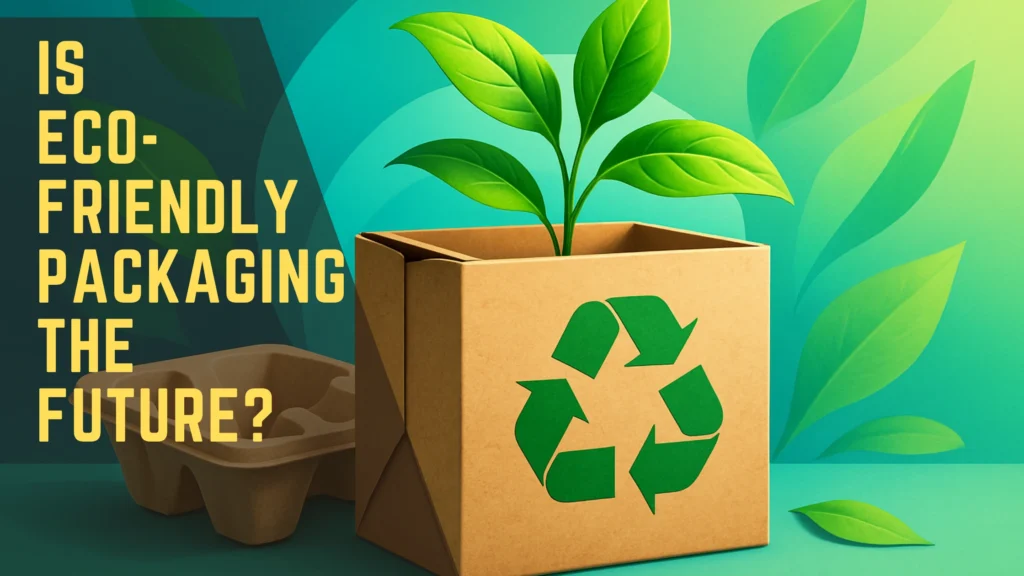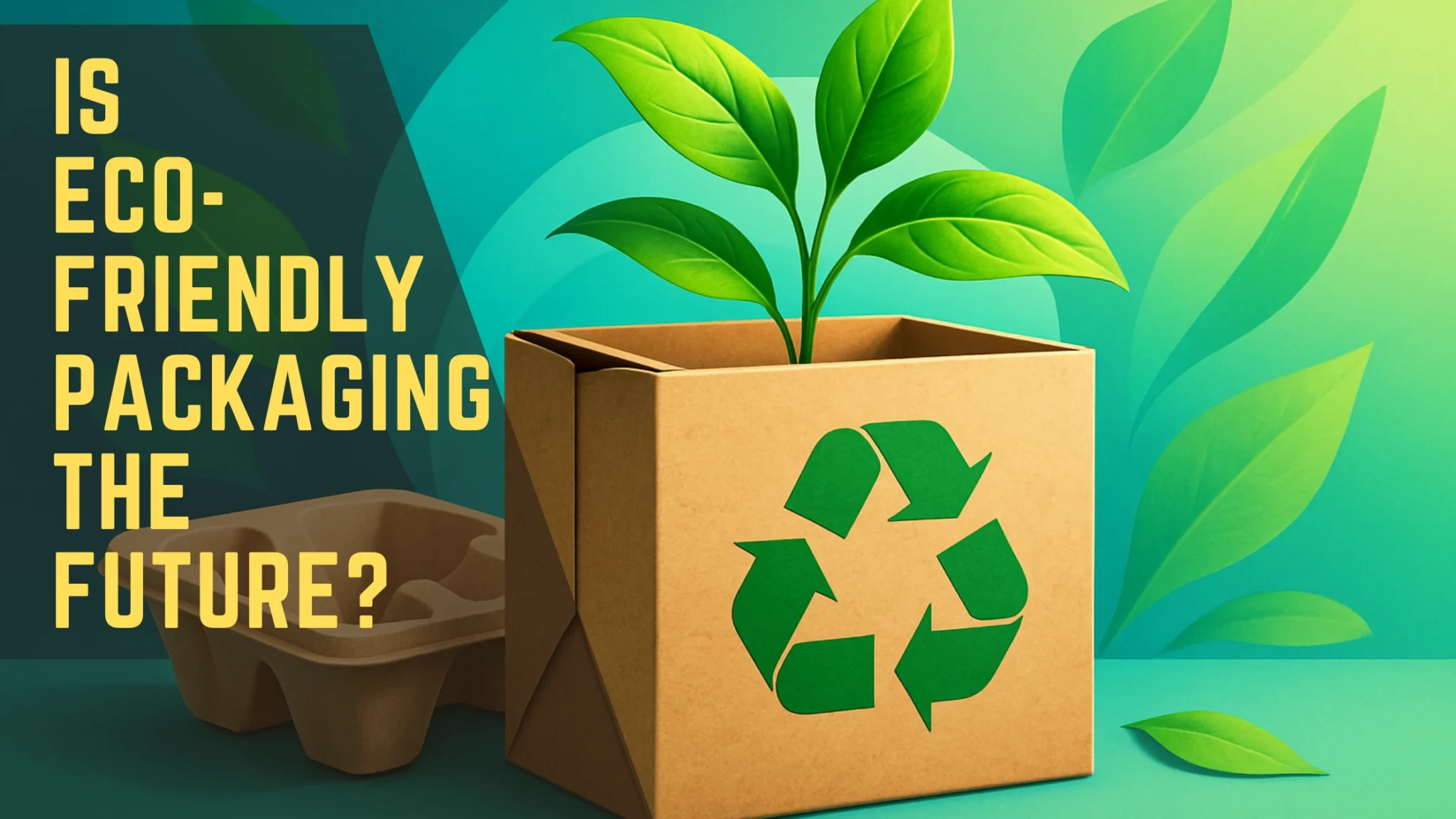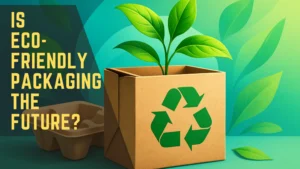Introduction
When a customer first sees your product, the packaging speaks louder than words. It’s the very first impression, one that can spark curiosity, build trust, and even drive an instant purchase.
But today’s buyers are not just looking at colors, logos, or shapes. They’re asking: “Is this packaging eco-friendly? Does this brand care about the planet?”
The truth is, packaging is no longer just about protecting a product, it’s about protecting our future. With rising concerns about plastic waste, climate change, and stricter environmental regulations, businesses are under growing pressure to adopt eco-friendly packaging solutions. And here’s the good news: sustainable packaging isn’t just good for the environment, it’s also good for your brand image, customer loyalty, and bottom line..
In this guide, we explore practical eco-friendly packaging solutions for a sustainable future. Learn about the latest materials, smart design strategies, cost factors, and step-by-step ways any business can transition to sustainable packaging—with real-world examples and industry insights to help you take action confidently.”
Why Eco-Friendly Packaging Matters in 2025
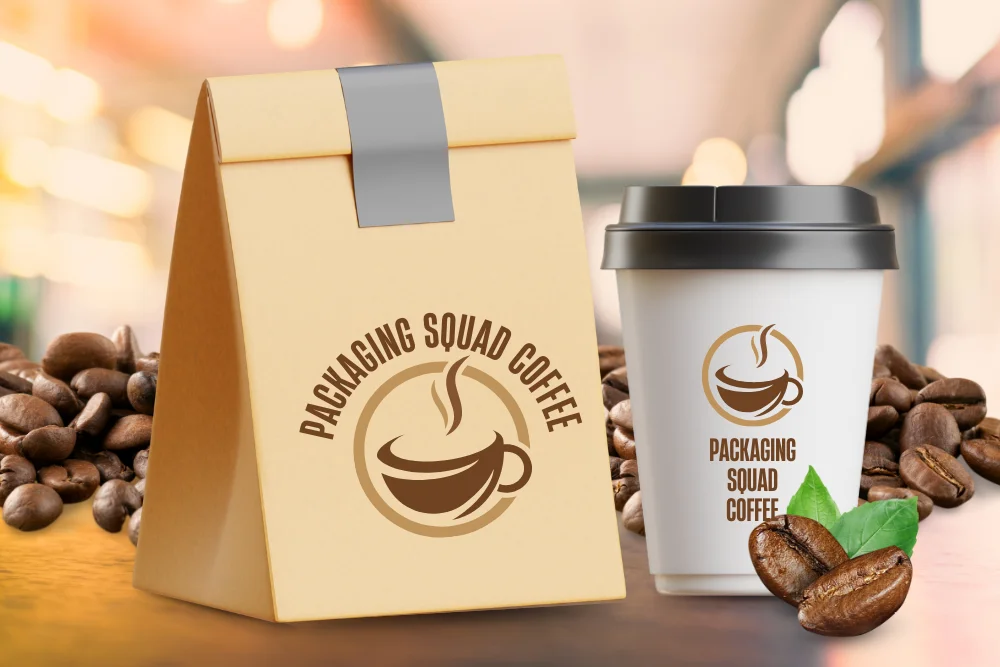
In 2025, eco-friendly packaging is no longer optional, it’s essential. Growing consumer demand, stricter environmental regulations, and rising awareness of climate change are transforming the packaging industry.
Businesses that fail to adopt sustainable packaging solutions risk losing customers and falling behind competitors.
Eco-friendly packaging not only reduces waste and protects natural resources but also strengthens brand reputation in a market that values sustainability
Here are the biggest reasons why eco-friendly packaging is leading the way in 2025.
1. Consumer Demand is Rising
Recent surveys show that 60–70% of consumers are willing to pay more for products with sustainable packaging. Shoppers, especially Millennials and Gen Z, actively prefer brands that align with their environmental values. Packaging is one of the easiest ways for your brand to show that commitment.
Example: Think of unboxing experiences shared on social media. A product wrapped in recyclable kraft paper creates positive buzz, while one packed in layers of plastic may spark criticism.
2. Regulations Are Changing the Game
Governments worldwide are banning single-use plastics, setting recycling targets, and offering incentives for sustainable practices. From Europe’s strict packaging waste directives to Canada’s ban on plastic bags, businesses need to adapt—or risk facing penalties.
3. Brand Reputation & Loyalty
Eco-friendly packaging builds trust and long-term customer loyalty. When customers see that your business makes thoughtful choices for the planet, they’re more likely to recommend your brand, repurchase, and engage with your content.
4. A Smart Business Move
Sustainability isn’t just about “going green”—it’s also about saving green. Eco-friendly materials like corrugated cardboard or molded pulp can be more cost-effective in the long run by reducing excess material, lowering shipping weights, and minimizing waste disposal costs.
What Makes Packaging Eco-Friendly?
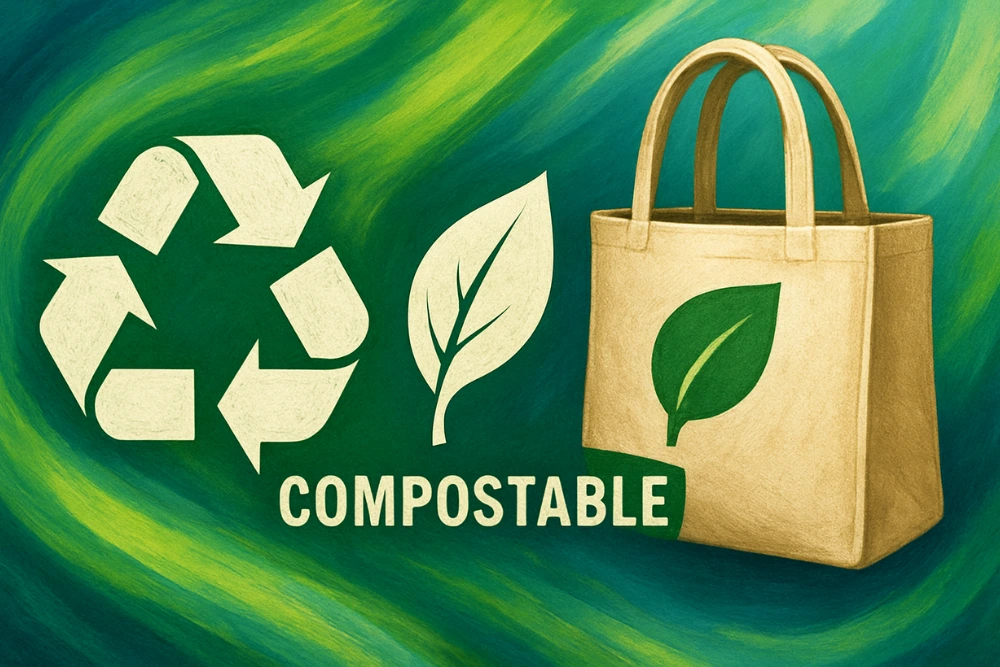
Not every “green-looking” package is truly sustainable. For packaging to be considered eco-friendly, it must minimize environmental harm throughout its lifecycle, from production and use to disposal. That means less waste, fewer harmful chemicals, and materials that can either return safely to the environment or be reused again.
Here are the key characteristics that define eco-friendly packaging:
1. Recyclable
Packaging that can be collected, processed, and turned into new products.
- Example: Corrugated cardboard boxes are widely recycled across the globe.
2. Compostable
Materials that break down naturally and leave behind no harmful residue.
- Example: Plant-based films or molded pulp trays for food products.
3. Reusable
Packaging designed for multiple uses, extending its lifecycle.
- Example: Rigid gift boxes or fabric bags that customers keep.
4. Minimalist Design
Using less ink, lightweight materials, and avoiding unnecessary coatings. This reduces carbon footprint and makes recycling easier.
5. Made from Renewable Resources
Materials sourced from plants, recycled fibers, or natural substances instead of fossil fuels.
- Example: Kraft paper made from responsibly managed forests.
Eco vs. Traditional Packaging: A Quick Comparison
| Feature | Traditional Packaging | Eco-Friendly Packaging |
| Environmental Impact | High waste, landfill buildup | Reduced footprint, recyclable |
| Cost (Long-Term) | Cheap upfront, wasteful later | Competitive, reduces waste costs |
| Consumer Appeal | Neutral or negative | Positive, brand trust-building |
| Regulation Risk | Increasingly restricted | Future-proof & compliant |
Top Eco-Friendly Packaging Materials for 2025 and Beyond
Choosing the right material is the foundation of sustainable packaging. The best eco-friendly options not only reduce environmental harm but also provide durability, print quality, and affordability for businesses. Here are the most effective materials to consider:
1. Kraft Paper
- Why it’s eco-friendly: 100% recyclable, biodegradable, and made from natural fibers.
- Best for: Food wraps, retail bags, and lightweight product packaging.
- Extra benefit: Affordable and widely available, making it ideal for small businesses.
2. Corrugated Cardboard
- Why it’s eco-friendly: Strong, recyclable, and lightweight—perfect for shipping.
- Best for: Subscription boxes, e-commerce shipping, and protective packaging.
- Extra benefit: Easily customizable with eco-friendly printing methods.
3. Molded Pulp (Paper Pulp Packaging)
- Why it’s eco-friendly: Made from recycled paper and compostable at the end of its life.
- Best for: Electronics, cosmetics, fragile items.
- Extra benefit: A natural replacement for Styrofoam inserts.
4. Bioplastics (Plant-Based Plastics)
- Why it’s eco-friendly: Derived from renewable plant sources like corn starch instead of petroleum.
- Best for: Food packaging, pouches, and films.
- Extra benefit: Many bioplastics are compostable, reducing landfill waste.
5. Glass and Metal
- Why it’s eco-friendly: Infinitely recyclable without losing quality.
- Best for: Premium beverages, perfumes, or luxury packaging.
- Extra benefit: Gives products a high-end, reusable appeal.
6. Fabric Packaging (Cotton, Jute, Non-Woven Bags)
- Why it’s eco-friendly: Natural fibers that are biodegradable and reusable.
- Best for: Tote bags, retail carry bags, and reusable promotional packaging.
- Extra benefit: Keeps your brand visible long after the purchase.
Pros & Cons of Popular Eco-Friendly Materials
| Material | Pros | Cons |
| Kraft Paper | Affordable, recyclable, biodegradable | Not suitable for heavy items |
| Cardboard | Strong, customizable, recyclable | Bulkier than plastic in some cases |
| Molded Pulp | Compostable, protective | Limited to certain shapes/products |
| Bioplastics | Plant-based, compostable | Higher cost, industrial composting needed |
| Glass & Metal | Premium look, endlessly recyclable | Heavy, higher shipping costs |
| Fabric Bags | Reusable, brand visibility | Higher initial production cost |
7 Practical Eco-Friendly Packaging Solutions Businesses Can Apply
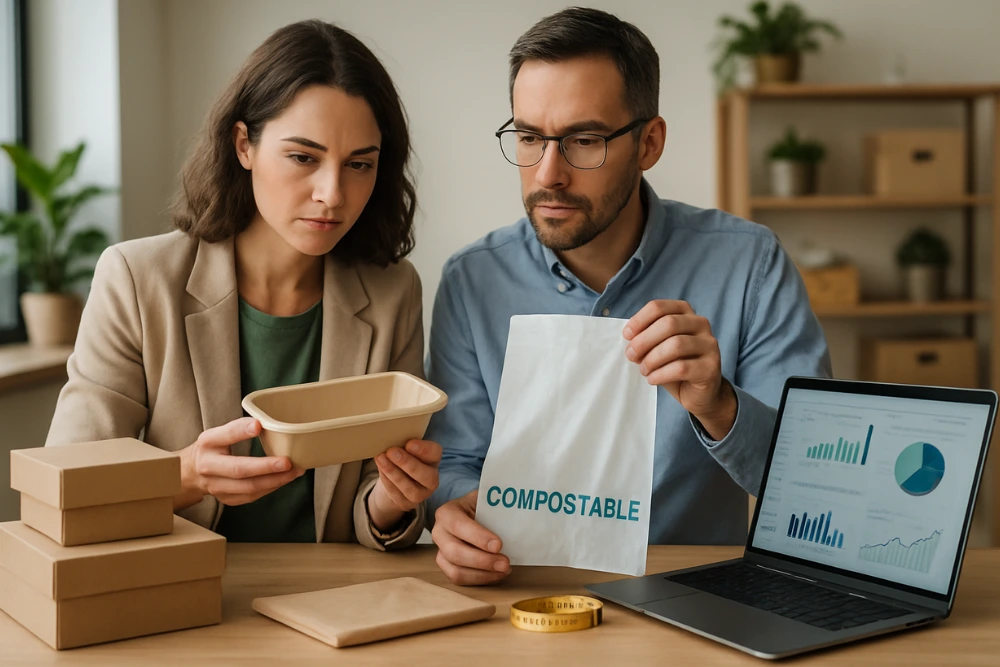
Switching to sustainable packaging doesn’t have to happen all at once. Businesses—whether small startups or established brands,can start with simple, cost-effective steps that make a real difference.
Here are seven practical solutions you can apply right away:
1. Switch to Recyclable Cardboard Boxes
Cardboard remains the most common and effective eco-friendly packaging material. By choosing recyclable corrugated boxes, you reduce plastic waste while giving your brand more customization options with eco-friendly inks and finishes.
👉 Try our Custom Box Price Calculator to explore cost-effective cardboard packaging solutions.
2. Use Minimalist Printing & Eco-Friendly Inks
Less is more when it comes to sustainable design. Heavy coatings and glossy finishes often make recycling difficult. Instead, use soy-based inks or water-based coatings—they’re safer for the planet and look modern, clean, and elegant.
3. Adopt Compostable Packaging Films
For food, snacks, or perishable items, plant-based films are a strong alternative to single-use plastics. They decompose naturally and resonate with eco-conscious consumers who look for compostable labels.
4. Design Reusable Packaging
Think beyond “single-use.” Rigid boxes, magnetic closure boxes, or fabric pouches encourage customers to reuse them for storage or gifting. This not only reduces waste but also keeps your branding visible long after the first purchase.
5. Right-Size Your Packaging
Oversized packaging wastes materials and increases shipping costs. Smart sizing solutions cut waste, improve logistics, and reduce your carbon footprint. For e-commerce brands, right-sizing also improves customer satisfaction by reducing excess filler.
6. Use Digital Printing for Small Runs
Traditional printing methods can produce waste when you need smaller quantities. Digital printing offers precision, less ink waste, and is cost-effective for limited-edition or seasonal packaging designs.
7. Educate Customers with Eco Labels & Instructions
Even the best sustainable packaging can end up in the wrong place if customers don’t know how to dispose of it. Add clear recycling symbols, compost instructions, or a simple eco-friendly message. Customers appreciate brands that guide them in making the right choice.
How Small Businesses Can Transition to Eco-Friendly Packaging
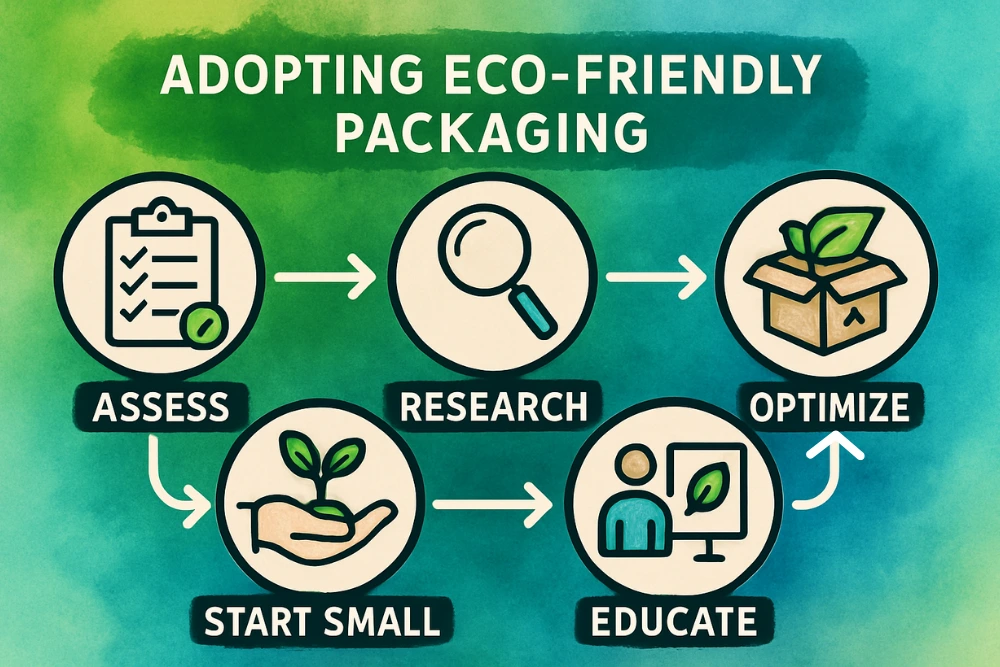
Shifting to sustainable packaging may feel overwhelming, especially for small businesses with limited budgets. But when you break it down into clear steps, the process becomes manageable and cost-effective. Here’s a roadmap any brand can follow:
Step 1: Assess Your Current Packaging
- List all materials you currently use (plastic, cardboard, fillers, labels).
- Identify what’s recyclable, reusable, or wasteful.
- Pinpoint which items customers often complain about (too much plastic, oversized boxes, etc.).
Step 2: Research Eco-Friendly Alternatives
- Explore options like kraft paper, corrugated boxes, compostable films, and fabric bags.
- Consider your product type (fragile, perishable, luxury) when selecting materials.
- Look for suppliers who provide certifications (FSC-certified paper, compostable labels, etc.).
Step 3: Start Small with High-Impact Changes
- Replace plastic fillers with shredded kraft paper or molded pulp.
- Switch mailing bags to recyclable paper-based options.
- Reduce unnecessary layers of packaging (minimalist design saves money + materials).
Step 4: Test Your Packaging
- Try small runs before fully switching.
- Collect customer feedback about usability, durability, and eco-appeal.
- Adjust design or material if customers face issues (like leakage, tearing, or bulkiness).
Step 5: Optimize Costs with Smart Tools
- Use a Custom Box Price Calculator to estimate costs and compare materials.
- Order in bulk when possible to reduce per-unit pricing.
- Consider lightweight yet strong materials to save on shipping fees.
Step 6: Communicate Your Sustainability Efforts
- Add eco-labels or a short sustainability message on your packaging.
- Share your eco-friendly journey on social media, your website, or product inserts.
- Customers love supporting brands that show transparency and responsibility.
Step 7: Scale Up Over Time
- Once you’ve tested and optimized, expand sustainable packaging across all products.
- Keep monitoring new eco-materials and technologies emerging in the industry.
- Remember: sustainability is a continuous journey, not a one-time switch.
Benefits of Eco-Friendly Packaging for Brands (Short & Long Term)
Investing in sustainable packaging isn’t just about protecting the planet—it’s also about protecting and growing your business. Here’s how eco-friendly packaging delivers value both immediately and in the long run:
Short-Term Benefits
✅ Positive Customer Perception
Consumers notice when a brand makes eco-friendly choices. Sustainable packaging creates an immediate sense of trust and brand loyalty.
✅ Social Media Buzz
Eco-friendly packaging often looks minimal, modern, and share-worthy. A positive unboxing experience can spark organic engagement across Instagram, TikTok, and YouTube.
✅ Cost Savings from Smart Design
Right-sized packaging and reduced filler materials cut unnecessary expenses. For e-commerce brands, this also lowers shipping costs.
Long-Term Benefits
🌍 Stronger Brand Reputation
Sustainability is becoming a non-negotiable value for customers, especially Millennials and Gen Z. By committing early, your brand earns a strong reputation as a responsible leader.
🌱 Regulatory Compliance
Governments worldwide are enforcing stricter packaging laws (like bans on single-use plastics). By transitioning now, your business avoids penalties and future disruptions.
📈 Competitive Advantage
Eco-friendly packaging differentiates you from competitors who still rely on wasteful methods. Over time, this becomes a key factor in winning new markets and retaining eco-conscious buyers.
💡 Long-Term Cost Efficiency
As sustainable packaging technologies evolve, prices are dropping. Early adopters who optimize processes now will save more in the future.
Common Myths About Eco-Friendly Packaging (and the Truth)
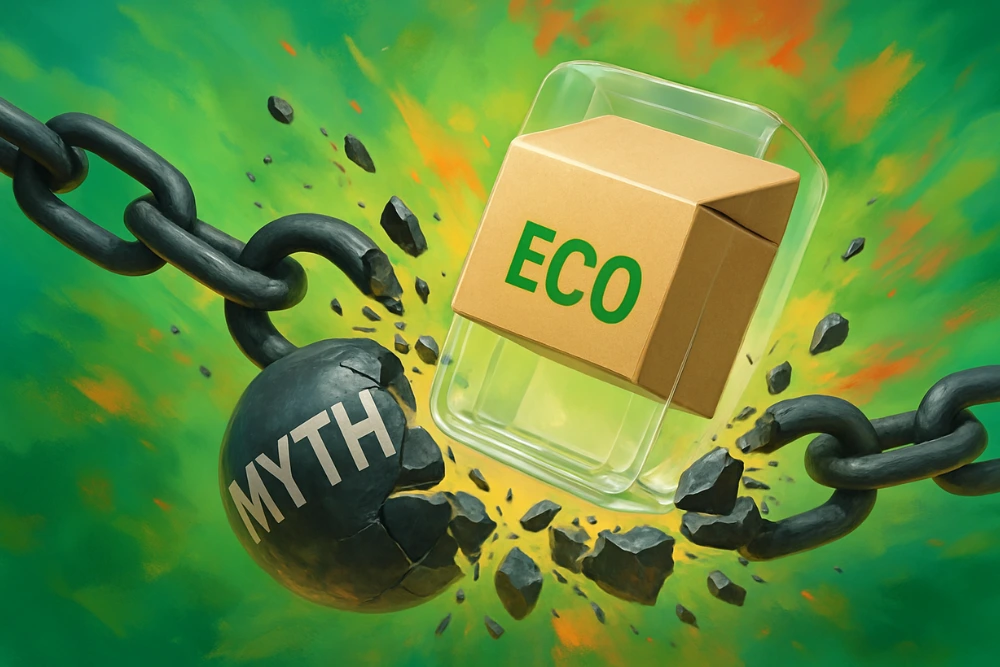
Even though sustainable packaging is gaining momentum, some misconceptions still hold brands back. Let’s clear up the most common ones:
❌ Myth 1: Eco-Friendly Packaging Is Too Expensive
✅ Truth: While some eco-materials may cost more upfront, smart design (right-sizing boxes, reducing fillers, lightweight shipping) often balances the cost—or even saves money in the long run. Plus, studies show customers are willing to pay more for sustainable packaging.
❌ Myth 2: Sustainable Packaging Looks Plain and Boring
✅ Truth: Modern eco-friendly packaging can be stylish, customizable, and brand-focused. Kraft boxes, soy-based inks, and minimalist designs actually make products look more premium and “Instagram-worthy.”
❌ Myth 3: Eco-Packaging Isn’t Durable Enough
✅ Truth: Materials like corrugated cardboard, rigid boxes, and biodegradable films are designed to protect products during shipping while still being recyclable or compostable. Many businesses successfully ship fragile items in eco-friendly options.
❌ Myth 4: Small Businesses Can’t Afford to Switch
✅ Truth: Switching doesn’t have to be all at once. Even small changes—like using paper tape instead of plastic, or recycled kraft mailers—show customers your brand cares. Packaging Squad even offers a Custom Box Price Calculator to help estimate costs before committing.
Conclusion: The Future of Packaging Is Green
Eco-friendly packaging is no longer just a passing trend—it’s the new standard for businesses that want to thrive in a competitive, environmentally conscious market. By adopting sustainable materials, right-sizing your packaging, and making small but impactful changes, you’re not only reducing waste but also building stronger trust with your customers.
At Packaging Squad, we understand that every business is different. That’s why we provide custom packaging boxes designed to balance sustainability, durability, and brand identity. Whether you’re just starting small changes or planning a full switch, our team is here to guide you.
👉 Ready to explore how much eco-friendly packaging might cost for your products? Try our Custom Box Price Calculator or visit our homepage to get started today.
✨ Want to make the switch to eco-friendly packaging? Check out our top picks on Amazon here too.
FAQs About Eco-Friendly Packaging Solutions
1. What is the most eco-friendly packaging material?
The most eco-friendly materials are recyclable and biodegradable options such as kraft paper, cardboard, compostable mailers, and plant-based plastics. They minimize environmental impact and can be reused or recycled.
2. Why is eco-friendly packaging important for businesses?
Eco-friendly packaging reduces waste, lowers carbon footprint, and shows customers that your brand cares about sustainability. In 2025, consumers increasingly choose brands that align with their environmental values.
3. Is eco-friendly packaging more expensive?
Not always. While some sustainable materials cost more upfront, right-sizing packaging and reducing unnecessary layers often save businesses money in shipping and storage. Plus, it increases brand loyalty, which pays off long-term.
4. How can small businesses switch to eco-friendly packaging?
Start small: use recyclable shipping boxes, paper-based fillers, or compostable bags. Then, scale up by investing in custom eco-friendly packaging boxes tailored to your products. Tools like a custom packaging calculator can help estimate costs.
5. Can eco-friendly packaging be customized for branding?
Yes! Sustainable packaging can still look premium. With the right printing methods and design, eco-friendly materials like kraft boxes or recycled cardboard can be customized with logos, colors, and finishes to reflect your brand identity.


